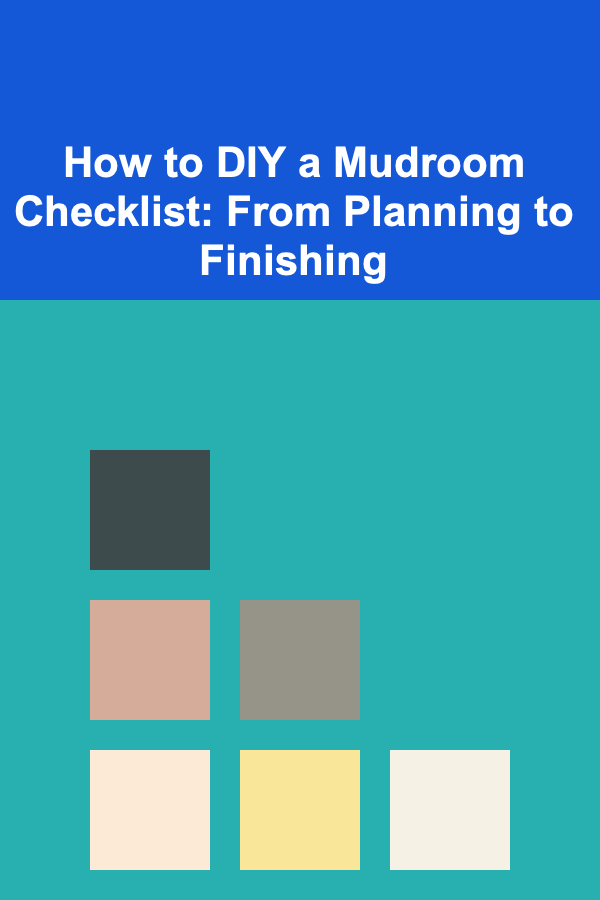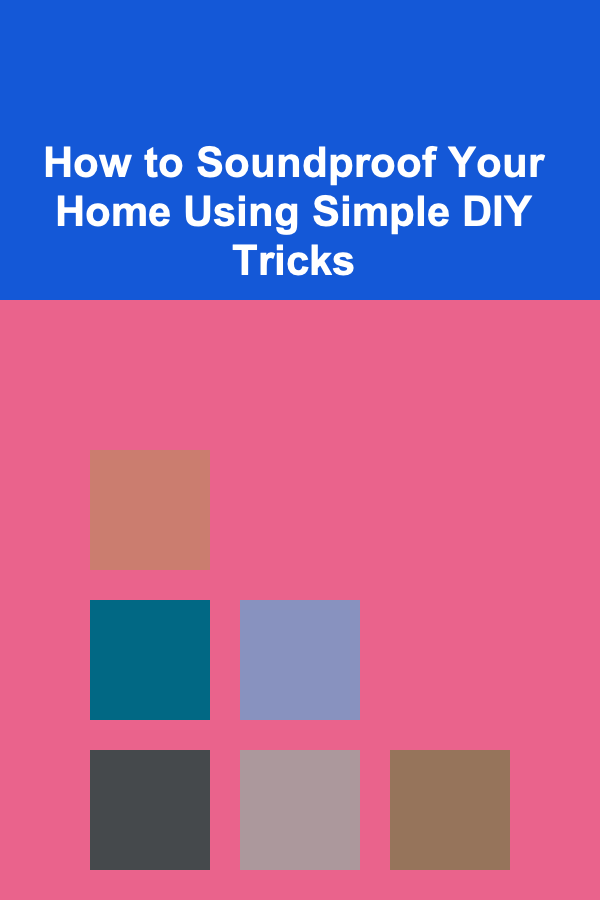
How to DIY a Mudroom Checklist: From Planning to Finishing
ebook include PDF & Audio bundle (Micro Guide)
$12.99$9.99
Limited Time Offer! Order within the next:

A mudroom is a valuable addition to any home, providing a dedicated space for shoes, coats, bags, and other outdoor gear. It's an area where you can drop off items as you enter the house and avoid bringing dirt and clutter into your living spaces. Creating your own mudroom can be a fun and rewarding project that enhances your home's functionality and aesthetic.
This comprehensive guide will walk you through a step-by-step DIY mudroom checklist, covering everything from planning and designing to completing the finishing touches. Whether you have a small entryway or a large hallway, we will help you create a custom space that fits your needs, style, and budget.
Step 1: Assess Your Space and Define Your Needs
Before diving into any DIY project, it's essential to assess the space you're working with and determine what you need from your mudroom. Consider the following questions:
1.1. What is the size of the available space?
Start by measuring the dimensions of the area where you plan to create your mudroom. Is it a small hallway, an unused corner of the house, or a separate room? Knowing the size of your space will guide your design choices and storage options.
1.2. How many people will be using the mudroom?
If you have a large family, you'll likely need more storage and seating. Consider how many people will be entering the mudroom at once and whether you'll need hooks, cubbies, or shelves to accommodate everyone.
1.3. What items do you need to store?
Think about what you'll be storing in your mudroom. Will you need a place for shoes, jackets, bags, or hats? Do you want a spot for your pets' leashes or a charging station for devices? By defining your storage needs, you'll be able to create a more organized and functional space.
Step 2: Design Your Mudroom
Once you've assessed your space and needs, it's time to start designing your mudroom. The design phase will involve selecting materials, storage options, and layout ideas that suit your taste and functional requirements. Here are some things to consider during this phase:
2.1. Choose a Layout
Depending on the size and shape of your space, there are several possible layouts for your mudroom:
- Linear Layout: Ideal for narrow spaces like hallways, where you can line up hooks, shelves, and benches along one wall.
- U-Shaped Layout: A great option for larger spaces, where you can create separate areas for hanging coats, storing shoes, and keeping bags.
- L-Shaped Layout: Works well for corner spaces or if you want a more open design that doesn't block entryways.
- Separate Room Layout: If you have a larger space or a dedicated mudroom, you can incorporate different zones like a coat closet, shoe storage, and a bench area.
2.2. Select Materials
The materials you choose for your mudroom will affect both its functionality and appearance. Consider durable, easy-to-clean options for floors, walls, and storage units:
- Flooring: Opt for tile, vinyl, or wood for easy maintenance. Tiles are durable and water-resistant, while vinyl is affordable and low-maintenance.
- Wall Finish: Mudrooms are prone to dirt and scuff marks, so choose materials that are easy to wipe down. Consider beadboard, shiplap, or painted drywall.
- Storage: Wood is a classic choice for cabinets and shelves, but metal or plastic may be better suited for high-moisture areas.
- Seating: A bench is a must for most mudrooms. You can use a simple wooden bench or a cushioned one for added comfort.
2.3. Plan for Storage
A functional mudroom should have ample storage to keep everything organized. Some essential storage options include:
- Hooks: Install hooks for hanging coats, bags, and hats. You can mix large and small hooks to accommodate different items.
- Shelves: Install shelves for storing baskets, gloves, and other smaller items. Open shelving provides easy access, while closed cabinets can hide clutter.
- Cubbies: Cubbies are perfect for family members who need a dedicated space for shoes, bags, or hats. You can label each cubby to help keep things organized.
- Drawers: If you prefer a more streamlined look, add drawers to store small items like scarves, keys, or pet leashes.
2.4. Personalize the Design
A mudroom should reflect your home's overall aesthetic, so consider adding personal touches like:
- Paint colors: Light colors like white or soft gray create an airy and clean look, while bold colors like navy or green can add character and warmth.
- Wall décor: Add mirrors, framed photos, or hooks in unique shapes for a touch of style.
- Textiles: Soft furnishings like pillows or a rug can make your mudroom feel cozy and inviting.
Step 3: Gather Materials and Tools
Now that you've designed your mudroom, it's time to gather the necessary materials and tools for the project. Here's a list of what you might need:
3.1. Materials
- Lumber or MDF boards (for shelves, cabinets, and bench)
- Hooks or pegs (for coats and bags)
- Screws, nails, or brackets
- Paint or wood stain
- Tile, vinyl, or hardwood flooring
- Cubbies or baskets
- Bench cushions (optional)
- Wall panels (beadboard, shiplap, or drywall)
3.2. Tools
- Measuring tape
- Level
- Screwdriver
- Drill
- Saw (if you need to cut boards)
- Paintbrushes or rollers
- Caulking gun (for sealing gaps around shelves or walls)
- Hammer
3.3. Prep Work
Before starting the construction phase, prepare your space:
- Clear the area of any furniture, dust, or debris.
- Patch up any holes or cracks in the walls.
- Ensure the flooring is even and clean.
Step 4: Build Your Mudroom
With your materials and tools ready, you can begin building your mudroom. Here's a basic overview of the steps to follow:
4.1. Install Shelving or Cubbies
Start by installing shelves or cubbies on the walls. Make sure to measure and mark where you want them to go. Use a level to ensure everything is straight, and screw the shelves or cubbies securely into the wall studs.
4.2. Build the Bench
If you're adding a bench to your mudroom, begin by constructing the frame. You can use plywood or MDF to build the seat, and attach it to the wall for stability. If you want a cushioned bench, add foam padding and cover it with fabric for a comfortable seat.
4.3. Install Hooks or Pegs
Next, install hooks or pegs at a comfortable height for coats, hats, and bags. If you're using multiple hooks, space them out evenly and ensure they are sturdy enough to hold heavy items.
4.4. Add the Finishing Touches
Once the major components are installed, it's time to add finishing touches. Paint or stain any exposed wood surfaces, install trim around the edges, and place decorative items like rugs, mirrors, or artwork.
Step 5: Final Inspection and Clean-Up
After completing your mudroom, do a final inspection to ensure everything is secure and functional. Check that shelves are level, hooks are firmly attached, and the bench is sturdy. Make any necessary adjustments before moving in your gear.
Finally, clean up the space by wiping down surfaces and vacuuming the floor. Your DIY mudroom is now ready for use!
Conclusion
Building a mudroom is a great way to improve the functionality and organization of your home. By following this DIY checklist, you can create a custom space that meets your needs and fits your style. Whether you're working with a small entryway or a larger area, this project can be completed on a budget and with a bit of creativity. With a little effort and planning, you'll have a mudroom that enhances your home's entryway and helps keep your space clean and organized for years to come.
Reading More From Our Other Websites
- [Organization Tip 101] Best Organization Tools for Students
- [Organization Tip 101] How to Organize Your Workshop or Craft Room Paperwork
- [Organization Tip 101] How to Organize Your Kids' Clothes by Season
- [Toy Making Tip 101] Best Guide to Hand‑Stitching Soft‑Toy Parts for Durable, Machine‑Washable Results
- [Toy Making Tip 101] Best Color Theory Hacks for Designing Eye‑Catching Toy Car Sets
- [Biking 101] The Ultimate Guide to Cycling Workouts: Training Tips and Techniques
- [Personal Investment 101] How to Invest in International Markets for Diversification
- [Organization Tip 101] How to Share Your Rental Organization Journey Online
- [Home Budget 101] How to Use Financial Planning Tools for Home Budgeting
- [Small Business 101] Essential Small Business Resources Every Startup Needs

How to Incorporate Lighting for a Functional Garage Space
Read More
How to Soundproof Your Home Using Simple DIY Tricks
Read More
The Ultimate Guide to Lowering Auto Loan Interest Rates and Reducing Debt
Read More
How to Design Parametric Models for 3D Printing
Read More
Protecting Your Privacy While Working Remotely: A Comprehensive Guide
Read More
How to Design Printable Wall Art for Small Spaces
Read MoreOther Products

How to Incorporate Lighting for a Functional Garage Space
Read More
How to Soundproof Your Home Using Simple DIY Tricks
Read More
The Ultimate Guide to Lowering Auto Loan Interest Rates and Reducing Debt
Read More
How to Design Parametric Models for 3D Printing
Read More
Protecting Your Privacy While Working Remotely: A Comprehensive Guide
Read More